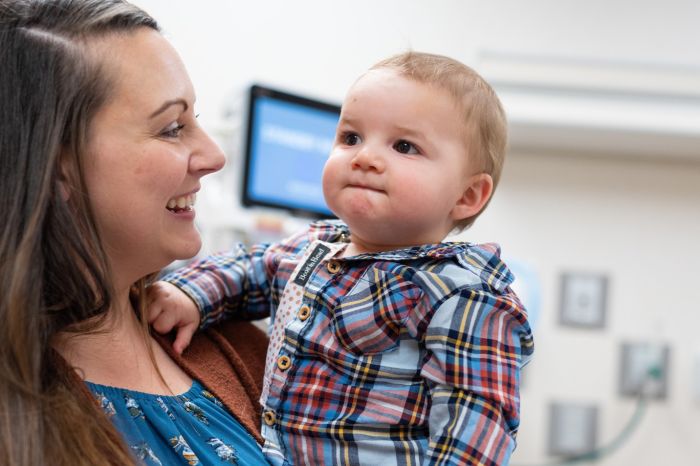Watch an appointment.
Gillette Children’s recently launched a pilot study looking at Constraint Induced Movement Therapy (CIMT) and its effects on infants with hemiplegic cerebral palsy (CP). Mark Gormley, MD, physical medicine and rehabilitation physician, and Kelli Moberg, occupational therapist (OT), national expert in Infant CIMT, are hoping to prove that infants who complete CIMT make meaningful, positive change in their functional abilities – even years later.
“At Gillette Children’s, we’ve really wanted to focus on getting infants and toddlers into treatment as early as possible to take advantage of the amazing neuroplasticity of infant brains. The earlier a child can get diagnosed and begin treatment, the better their outcomes,” says Gormley. “This study is just one of the ways we’re making sure that we’re setting up patients who have developmental conditions to have the best function and quality of life possible.”
What is CIMT?
Constraint Induced Movement Therapy (CIMT) is an occupational therapy treatment modality to treat children who have neuromotor conditions that affect one side of their body. Some children who have neuromotor conditions avoid using two hands, instead default to use only their stronger hand. In CIMT, the patient wears a restraint on their stronger hand as their weaker hand is guided through various activities and exercises.
CIMT encourages infants and children to use their weaker hand, which helps them strengthen it. Following this, without the restraint, they learn with targeted two-handed training to use the weaker hand more skillfully, especially in two-handed, or bimanual, activities. Moberg says, “There are a lot of activities during our day where we use two hands – dressing, grooming, participating in school, play and work. Our ultimate goal is the child will use their weaker hand for the rest of their life as the best helper hand it can be.”
Looking at CIMT for Infants
It’s well published that CIMT is an effective treatment in children aged 2 and older. Moberg says, “There are not a lot of studies published on using CIMT in infants. However, results are showing this is the optimal time to initiate treatment.”
The main phase of Gormley and Moberg’s study involves 5 participants beginning treatment between 5 and 12 months old. Each participant wears a mitten on their stronger hand for 30 minutes a day, over the course of multiple weeks, up to at least 40 hours of wear time. Moberg and other OTs will work in clinic to teach the caregivers how to help the babies use the weaker hand, and then both hands together. Moberg also guides the family on what activities to do each day at home during each stage of the process.
Infants will also be wearing accelerometers on each wrist to measure movement both in clinic and at home. “One of the big questions I had was when the babies are at home, are they using their affected limb more?” says Dr. Gormley. “So, unique to our study design, we devised the use of an accelerometer for the infants to wear on both wrists before and after treatment.”
Quantifying Progress in CIMT
To measure the relative success of CIMT in each infant, Moberg and Gormley will assess participants before infant CIMT starts, during infant CIMT, and at intervals after infant CIMT until the participant reaches age 4.
To measure clinical outcomes, Moberg uses the gold standard Assisting Hand Assessment family of assessments including the Mini- Assisting Hand Assessment, Assisting Hand Assessment and Hand Assessment for Infants as the primary outcome measures. These have been developed by world - experts in Sweden and Australia. The Mini/Assisting Hand Assessment provide a hierarchy of children’s hand skills that guide treatment. Participants in the study will work on skills in clinic and at home.
As for the accelerometers, Gormley and Moberg will use them to measure how much the babies are using their upper limbs on a day-to-day basis. After correcting for participant growth, the team will use the accelerometer data to compare the infants’ use of their weaker and stronger hands as well as the infants’ weaker hand movement data over time.
Preliminary Observations Spark Excitement for the Future
Though the pilot is following a small number of patients, preliminary observation seems to show great promise. Moberg says, “The infants’ gains have been more robust than the older kids we have seen who have started at 24 months of age or older. It’s showing we're having a much bigger impact by initiating treatment before they're 24 months of age than if we did later.”
The team is very excited to be able to see infants that have been identified as being at risk or diagnosed with hemiplegic CP and start treatment early. Gormley says, “We're going to make a much bigger change if we can incorporate this type of treatment very, very early on in the care of a child. it's clear that the earlier you intervene, the more change you can make.“
After the pilot concludes, the hope is to expand the study to a larger multicenter trial.
Join Our Partners in Care Community!
Subscribe to Partners in Care Journal, a newsletter for medical professionals.
Subscribe Today Home Page
Home Page

